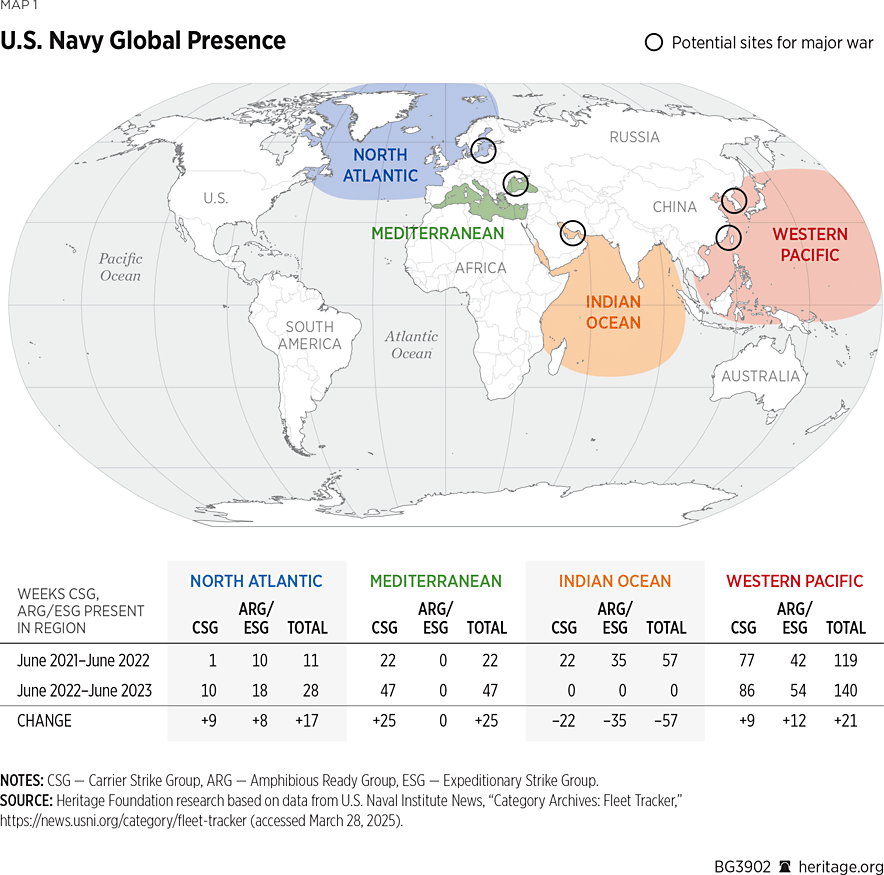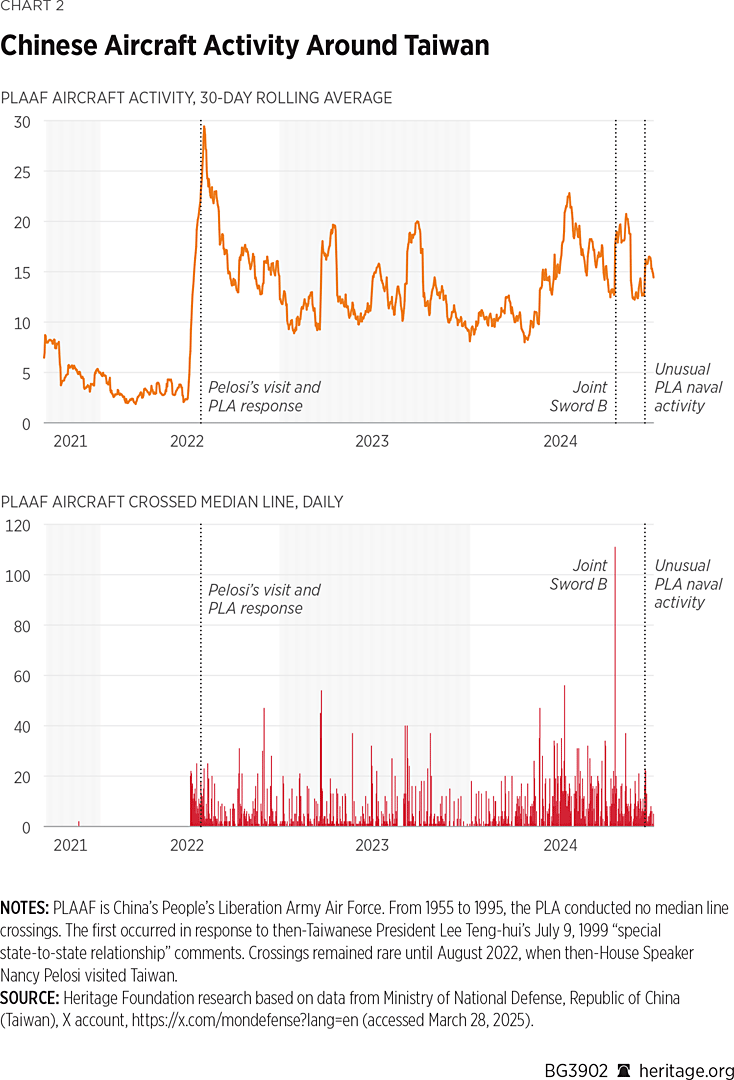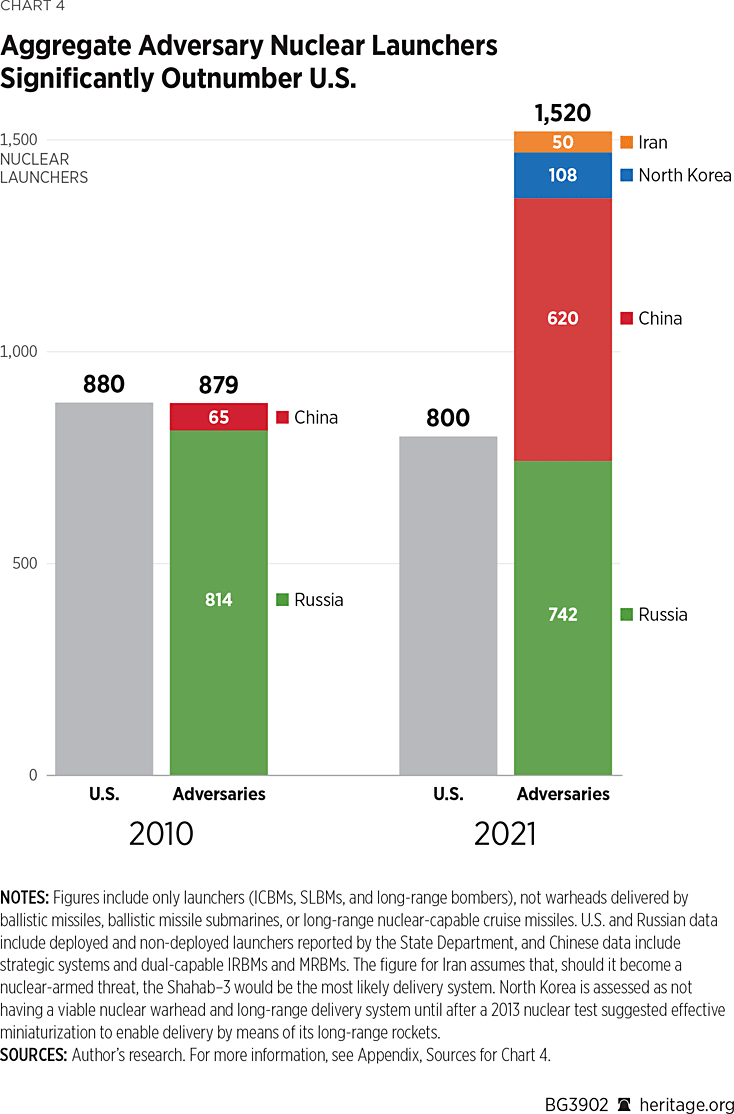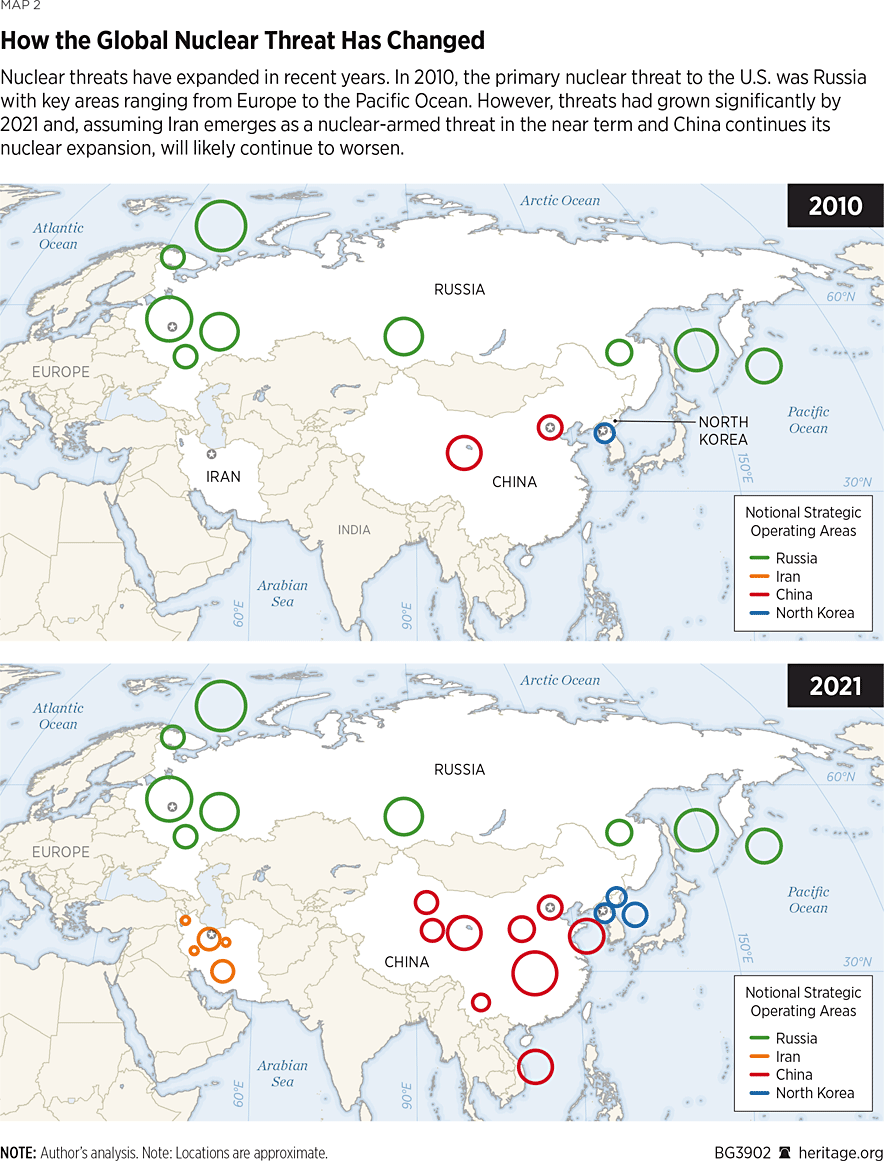Nearly four years ago, the Indo–Pacific Commander, Admiral Philip Davidson, gave the warning that the Chinese Communist Party was preparing for a war with the U.S. by 2027.REF Since that time, too little meaningful progress has been achieved to alter the military balance and deter China’s leaders from acting on that goal—to defeat the U.S. and subjugate Taiwan.REF The urgency for real action cannot be understated; as time goes by there are fewer options available while the cost for real deterrence grows. Failing to act, however, could result in the most destructive and consequential war the U.S. has ever had to fight.
An Increasingly Dangerous World for America
As Americans go about their daily lives unmolested, the world is accelerating in its change—much of it perilous to U.S. national survival. The past four years has seen Iran’s proxy the Houthis engage the U.S. Navy in the Red Sea; Iranian proxies attack American armed forces across the Middle East without consequence; and, of course, Hamas’ coordinated, barbaric assault on Israel on October 7, 2023. And the avoidable war between Russia and Ukraine in its third year has settled into an unsustainable attritional contest due to a series of miscalculations and dithering by Washington.REF
China’s Bold Challenge. Finally, and most dangerously, on the back of a decades-long sustained military build-up, China’s military is increasingly confident and willing to directly challenge the U.S.REF Just last summer a scuffle between Chinese maritime forces and the Philippines at Second Thomas shoal resulted in serious injury. Significantly, such violence could trigger a U.S. response because the Philippines is a treaty ally.REF And China has normalized highly provocative military flights across the median line between China from Taiwan. This has occurred with such an intensity that the Indo–Pacific Command leader stated that Chinese military exercises in the summer of 2024 (combining all Chinese armed forces acting in concert) was the largest amphibious invasion rehearsal ever seen.REF
The Admiral also stated, “[A]ggressive maneuvers around Taiwan right now are not exercises, as they call them. They are rehearsals” that “could disguise intentions” (i.e., invasion).REF While the Biden Administration did send its diplomats and senior military leaders to the region often, words alone have not deterred China from its current path to confrontation. As such, the trajectory in this region is both unsustainable and increasingly dangerous.REF This need not be the case.
For the past four years, instead of bolstering the U.S. military and backing up proactive diplomacy with meaningful consequences to American adversaries, the nation is confronted by two wars and a simmering conflict in Asia that dates to the ill-executed 2021 evacuation from Afghanistan.
Russia and Ukraine. That debacle, along with confused diplomacy and no meaningful military posture adjustments, effectively gave Russia a green light for the February 2022 invasion of Ukraine. U.S. forces, which moved into Eastern Europe starting in January 2022, proved too late and too little to alter Russia’s calculus.REF While the U.S. and its allies rallied support once Ukraine had stymied the initial Russian onslaught, the overcautious and tardy delivery of weapons meant that the war predictably settled into a contest of attrition that favored Russia.
The military support for this preventable war drew munitions intended for Taiwan and Israel—notably the moving of guided munitions and artillery rounds from Israel in the months before Hamas’ October 7 assault.REF The U.S. Navy has since conducted naval combat operations on a scale not seen since World War II, as Iran’s proxy, the Houthis, attempted to sever nearby shipping lanes and attack Israel.REF This has resulted in significant depletion of expensive and hard-to-replace air and missile defense weapons like the Standard Missile 3 (SM-3) costing between $9 million to $28 million.REF
Why the Wait?
China is watching and calculating, but so far has not acted. There are several reasons for this.
NATO Unity. First, China is surely noting the unity of NATO and its increasing weapons expenditures by militaries that are interoperable. This was not in Chinese General Secretary Xi Jinping’s nor Russian President’s Vladimir Putin’s calculations for how a divided NATO on the eve of the February invasion of Ukraine would play out.REF That unity, paired with sustained increased defense spending, presents a potential united front with which China must contend. This union, however, remains tenuous and could easily revert to past behaviors that neglected military strengthening.
Naval Presence in the Western Pacific. Second, despite the chaos of the past several years, the U.S. Navy has managed to sustain significant presence in the western Pacific.REF This comes at a cost in added wear on the ships and sailors reliant on a logistics infrastructure of ports, support ships, and dry docks too few to assure contested forward naval operations.REF Case in point, the grounding of Navy tanker Big Horn in September 2024 jeopardized ongoing Red Sea combat operations by the Abraham Lincoln carrier strike group.REF That said, actions by allies Japan and Philippines in welcoming greater U.S. military presence somewhat offsets risks. These actions include establishing U.S.–Philippines Enhanced Defense Cooperation Agreement sites, which U.S. Marine Corps and Army forces have increasingly visited since the 2022 election of Filipino President Ferdinand “Bongbong” Marcos.REF


Support for Taiwan. Third, though inconsistent, the strong messages of support to Taiwan in the past few years clearly cause China unease. At the same time, this support has added uncertainty as to how rapid and significant U.S. support would be to the island.REF Troublingly, at the same time, China has used U.S. political support for Taiwan to rationalize a significant and sustained military presence that could easily mask an attack against the island, as the current commander of the Indo–Pacific Command has recently asserted.REF
The decision by the U.S. to intervene in a war over Taiwan is a function of the context of how that war starts. Importantly, Taiwan is where over 80,000 Americans (or more) live, work, or travel on any given day.REF As such, in that war of choice by China, those Americans would likely be casualties that would incite a vigorous American response. This is to say nothing of the economic damage that war would cause to everyday Americans. All told, Beijing has built and trained its military for confronting the American military response to its assault on Taiwan.REF


China’s Nuclear Arsenal Breakout. Finally, and perhaps most shocking, is China’s nuclear arsenal breakout. In 2021, satellite imagery uncovered three new fields of intercontinental ballistic missile (ICBM) silos being constructed in the Gobi Desert—quadrupling China’s ICBM arsenal to 400 missiles by mid-2024.REF In October 2021, it was reported China had tested a fractional orbital bombardment system that greatly complicates U.S. missile defenses with its unlimited range and vectors of attack.REF
The U.S. response has been lackluster in recapitalizing its nuclear deterrent forces: Columbia-class ballistic missile submarines are behind schedule and have too few missile tubes to meet the threat.REF And gaps in the U.S. nuclear escalation ladder have been dangerously evident at times. Case in point, amid the Ukraine war, Russia has made threats to use tactical nuclear weapons for which the U.S. and its allies have no comparable response option.REF


Restoring Deterrence with China
The challenge facing the U.S. today is how to restore an ebbing deterrence and prevent a war in Asia—while not ceding a democratic way of life and prosperity for the next generation. This will require several urgent actions:
- Bring the war in Ukraine to a conclusion while NATO restores its military capacities to enforce a sustained peace in Europe. This will allow U.S. munition production and military presence to be focused on the western Pacific.
- Support Israel’s and America’s Middle East allies in rolling back and severing Iran’s network of terrorist proxies—the goal being to prevent a repeat of the October 7 attacks and to pressure Tehran to focus internally rather than export its terrorism. This mitigates the potential for a crisis that would draw away U.S. forces needed in the Pacific to deter China.
- Operate the American military differently and in ways that complement diplomatic and economic statecraft. This will engender a rethinking of how American statecraft is executed—a retooling of American institutions to wage a new Cold War.REF The nation has done this before, as the Cold War with the Soviet Union was unfolding, Congress passed the National Security Act of 1947, establishing the Central Intelligence Agency and beginning a process of making U.S. military services more unified. Given the nature of the Chinese threat globally, and specifically against Taiwan, naval statecraft is the recommended way forward; that is, a maritime strategic framework for using American power.
- Commit to restoring the nation’s maritime industrial base vital to building and sustaining a Navy able to deter, fight, and win a prolonged conflict with China.REF This will require committing significant resources, akin to the build-up seen in the 1930s as the world edged to conflagration: A modern Naval Act is one way to accomplish this.REF Already, there is wide support for efforts to restore U.S. maritime industry with the Shipbuilding and Harbor Infrastructure for Prosperity and Security (SHIPS) for America Act, a promising first step to regain the ability to sustain a wartime economy in a prolonged war with China.REF
America-First National Security
Months into the America-First era under President Donald Trump, it is increasingly clear that there is a groundswell of support for action and an appreciation of the dangers the nation is confronting. Looking ahead, the early choices made by this Administration give some insight as to what is in store, but more is needed.
That said, recommendations to rapidly get the nation on track to sustain peace include:
- Engaging both Russia and Ukraine to end the war. Actions so far—and the recent public failed White House meeting between President Trump and Ukrainian President Volodymyr Zelenskyy—have invigorated long-delayed activities. America’s European allies have huddled and finally begun to commit real money to their own defense and explore ways of directly supporting Ukraine’s future security, such as deploying peacekeepers.REF In 2014, only Greece, the United Kingdom, and the U.S. met the agreed 2 percent of gross domestic product spent on defense; by 2023 that number has grown to include 11 NATO members when considering procurement of military capacities like tanks and airplanes.REF This is a positive, long-past-due development. That said, the devil will be in the details as to how long this peace is sustained and what U.S. defense resources can be moved to Asia.
- Supporting Israel and recommitting to the successful Abraham Accords. Relations soured by President Joe Biden with Saudi Arabia appear to be shifting to a positive trajectory with high-level engagements in Riyadh in mid-February.REF Promises by the White House to restore maximum sanctions on the regime in Tehran could see the needed rollback of Iran’s proxies and its destabilizing efforts.REF Yet uncertainty remains regarding what will be done to end the Houthi attacks on shipping in the Red Sea.
- Committing publicly to regaining U.S. industrial strength with a focus on shipbuilding, shipping, and the Navy. It was notable that the second defense department nominee announced after the Secretary of Defense was the Secretary of the Navy. However, given the long lead time required for shipbuilding, progress is urgently needed, and obtaining the rest of the maritime team at the Department of the Navy and Maritime Administration is needed to jump-start needed reforms and accelerate action.
- Accelerating delivery to Taiwan of already purchased arms. Harpoon anti-ship missiles—delayed due to engineering and production challenges—and their associate support systems are just arriving four years after being ordered, with delivery expected to be completed in 2028.REF Javelin and TOW-2B anti-tank missiles and stinger man-portable anti-air missiles have faced years of delays by inventories redirected to Ukraine and production bottlenecks.REF How the new Administration responds and accelerates the arming of Taiwan will be key in sustaining the military balance and peace in the near term. A strong Taiwan is a good deterrent against Chinese aggression and more likely to see a peaceful resolution of differences across the Taiwan Strait.
Peace Through Strength
Finally, it is worth noting again that deterrence of China will rest on a credible military, backed by a resilient wartime economy. Already two months into the Trump Administration it is clear that a break from the recent past in fast underway.
Brent D. Sadler is Senior Research Fellow for Naval Warfare and Advanced Technology in the Douglas and Sarah Allison Center for National Security at The Heritage Foundation.
Appendix: Sources for Chart 4
2010 Figures
- Amy F. Woolf, “U.S. Strategic Nuclear Forces: Background, Developments, and Issues,” Congressional Research Service Report for Members and Committees of Congress No. RL33640, updated December 14, 2021, p. 1, note 2, and p. 8, https://sgp.fas.org/crs/nuke/RL33640.pdf (accessed March 28, 2025).
- U.S. Department of Defense, Office of the Secretary of Defense, Annual Report to Congress: Military and Security Developments Involving the People’s Republic of China, 2011, p. 34, http://www.andrewerickson.com/wp-content/uploads/2015/11/DoD_China-Report_2011.pdf (accessed March 28, 2025).
2021 Figures
- Woolf, “U.S. Strategic Nuclear Forces: Background, Developments, and Issues,” pp. 1 and 8.
- U.S. Department of State, Bureau of Arms Control, Verification, and Compliance, “New START Treaty Aggregate Numbers of Strategic Offensive Arms,” Fact Sheet, September 1, 2021, https://www.state.gov/new-start-treaty-aggregate-numbers-of-strategic-offensive-arms/ (accessed March 28, 2025).
- International Institute for Strategic Studies, The Military Balance 2021: The Annual Assessment of Global Military Capabilities and Defence Economics (London: Routledge, 2021), pp. 48, 51, 191, 249, 255, 274–275, and 339, https://web.archive.org/web/20211229154216/https://hostnezt.com/cssfiles/currentaffairs/The%20Military%20Balance%202021.pdf (accessed March 28, 2025).
- Matt Korda and Hans Kristensen, “China Is Building a Second Nuclear Missile Silo Field,” Federation of American Scientists Blog, July 26, 2021, https://fas.org/blogs/security/2021/07/china-is-building-a-second-nuclear-missile-silo-field/ (accessed March 28, 2025).
- U.S. Department of Defense, Annual Report to Congress: Military and Security Developments Involving the People’s Republic of China, 2021, pp. 49 and 61.
- U.S. Defense Intelligence Agency, North Korea Military Power: A Growing Regional and Global Threat, 2021, pp. 22–26, https://www.dia.mil/Portals/110/Documents/News/NKMP.pdf (accessed March 28, 2025).
- Anthony H. Cordesman, Iran’s Rocket and Missile Forces and Strategic Options, Center for Strategic and International Studies, December 2014, pp. viii, 7–8, 71, 87, 99, and 108–109, https://csis-website-prod.s3.amazonaws.com/s3fs-public/legacy_files/files/publication/141218_Cordesman_IranRocketMissileForces_Web.pdf (accessed March 28, 2025).




